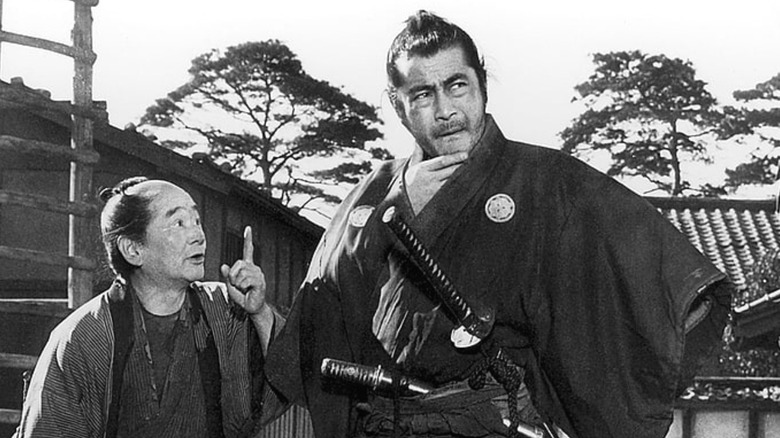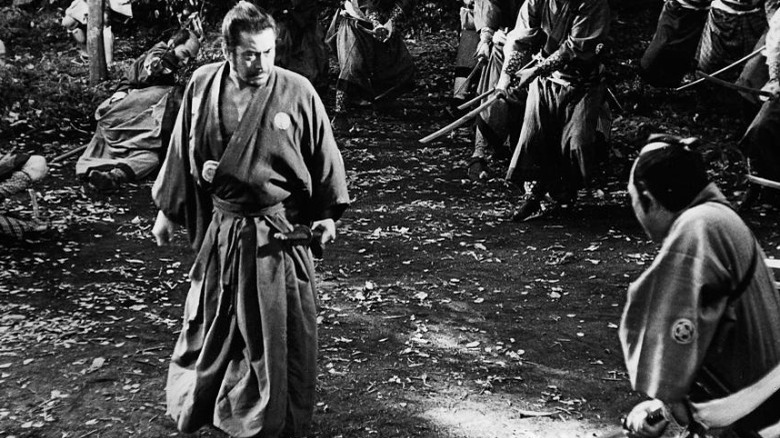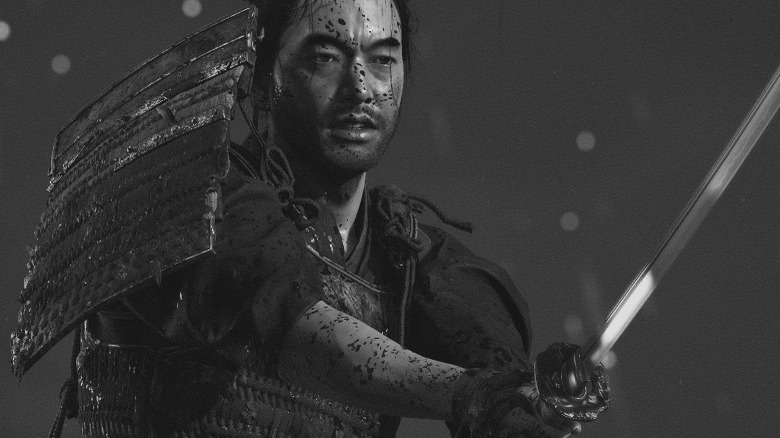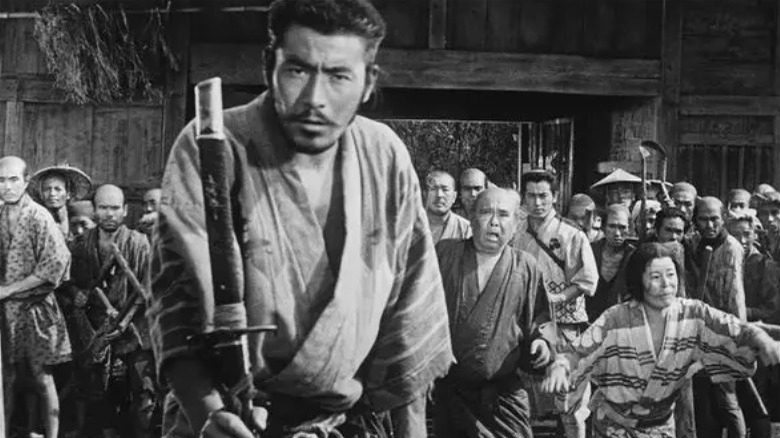The Two Akira Kurosawa Films That Inspired Ghost Of Tsushima
Folks who've played the samurai action-adventure game "Ghost of Tsushima" will be aware that the video game is a love letter to legendary filmmaker, Akira Kurosawa. Apart from the samurai-centric storyline and in-game aesthetics, there's also an exclusive Kurosawa Mode that allows players to duel or sneak up on characters while a black and white cinematic filter adorns the game. The creative directors behind "Ghost of Tsushima," Jason Connell and Nate Fox, have directly acknowledged Kurosawa's influence on their open-world samurai game on several occasions. But, are there specific Kurosawa films or philosophies championed by the director that played a role in shaping the world of "Ghost of Tsushima?"
The answer is yes. On a narrative level, "Ghost of Tsushima" follows a samurai named Jin Sakai, who must embark on a quest to protect Tsushima Island during the Mongol invasion of Japan in 1274. While the player holds the autonomy to choose the kind of combat they wish to engage in, the game subtly nudges Jin towards stealth modes of attack that lead to reduced risks and casualties.
However, this means giving up on the honorable samurai warrior code, as it is a violation of fair play and an established code of honor. Will the player choose a communal tenet of honorable existence or choose to avenge in ways that put the idea of the self first? "Ghost of Tsushima" delves deep into these warring philosophies, which unravel per the kind of gameplay one opts for. Interestingly, the conflict between the community and the individual acts as a core theme in several Kurosawa films, and the game upholds the director's vision in unstated ways. Here's a deep dive into how Kurosawa influenced the game and how "Ghost of Tsushima" functions as an interactive homage to the filmmaker.
The dignity and heart of a samurai
Connell and Fox spoke to Entertainment Weekly about the Kurosawa films that inspired the game, which include "Sanjuro" and the 1954 Kurosawa classic, "Seven Samurai:"
"I think one that is just crystal clear is the movie Sanjuro. It's a film that features, at the very end of it, a standoff between two samurai. The tension that those two warriors have, they wait for the other to make the first move, and then one of them dies with just one stroke of his sword. We tried to translate that into the standoff in our game very directly."
The game recreates the samurai standoff in "Sanjuro" via the final boss fight in the game, wherein Jin must defeat Lord Shimura and decide whether he should be killed or spared. The homage to "Sanjuro" is expertly crafted with the aid of the cinematic backdrop of the fight (with the sun setting near the beautiful fight space) and the emotionally-evocative dialogue exchanged between the two. Individualism and the samurai code of honor are preserved simultaneously in this scene, no matter how you choose to play it. Shimura rebukes Jin by saying, "You have no honor!" to which Jin replies, "And you're a slave to it!" This perfectly encapsulates the essence of "Sanjuro" and "Seven Samurai," as both films define a way of existence in complex plays by highlighting the dignity and heart of a true samurai warrior.
Other Kurosawa films that influenced the game include "Yojimbo," Red Beard," and "Ran," which dive into endless cycles of violence and the cost of the samurai code. The element of historical drama in these Kurosawa films also shaped the pseudo-historical narrative of the game, which is a mix of artistic liberties and grounded reality that heightens the player's experience.
Is the game's Kurosawa Mode a worthy homage?
It is easy to dismiss the game's Kurosawa Mode as an over-glorified black and white filter slapped on to give a nod to the Japanese director. However, Fox and Connell worked closely with the Kurosawa estate to make this happen and poured a lot of love into this fun little addition, which stands for more than it appears to.
Lighting and sound design were key aspects of any Kurosawa film — take "Throne of Blood" as an example, a film whose surreal, haunting atmosphere is thoroughly evoked with fog-drenched shots and the masterful interplay of light and darkness. Fox and Connell studied these aspects and diligently attempted to replicate them in Kurosawa Mode, which is as cinematic as it gets. Moreover, the enhanced shadows play a role in allowing Jin to stealth around and take down enemies from a distance, which is a key aspect of the third-person experience.
Another strength of the Kurosawa Mode when compared to the standard mode of gameplay is how sound is used to immerse players in a world removed from their own. The amplified wind sounds not only heighten tension but serve as a compass for players to move on to the next phase of gameplay. This makes Kurosawa Mode immensely interactive while essentially transporting players to the feudal Japan that is heavily featured in Kurosawa's filmography. While some might call Kurosawa Mode a shallow gimmick, there's definitely more to it than meets the eye. But that's for you to decide.
Individuality in the face of group-think and communal identity politics
Through films such as the rōnin-centered "Yojimbo" or the artistic "Ran," Kurosawa championed the theme of conflict between personal conflict and communal identity against a backdrop of sociopolitical violence. The samurai code of putting the country above personal preservation is open to interpretation in these films, and the game mimics this via Jin's storyline, which can be resolved through the player's choices. Despite the complexities of capturing real-life historical events that affected an entire nation, "Ghost of Tsushima" directs its focus on the thread of individuality that runs throughout the fabric of the game. This is accentuated via close-up character shots to capture their subtle emotionality and panoramic sweeps of the setting that shapes these characters, just like Kurosawa did.
However, choosing individuality comes with consequences, and the game does not shy away from incorporating this bitter truth into its storyline. If Jin embraces his titular persona and becomes the Ghost of Tsushima, the very people whom he is dedicated to protecting will haunt him for his dishonorable code of conduct. Whether Jin reacts to these repercussions with a sense of rightful retribution or humane empathy is up to the player, but the consequences are dire either way. The end is inevitable, ushered in by violence begotten by violence.
Nonetheless, things do not have to be so hopeless and bleak. It is up to you, the player, whether you will indulge in self-determinism or embrace traditional samurai ideals. Kurosawa's brand of heroism did not exist in a vacuum but was a reflection of personal philosophy/responsibility. Through Jin, players can enact this in their gameplay of "Ghost of Tsushima," which, despite its flaws, emerges as a culturally relevant video game that pays an informed, layered homage to Akira Kurosawa.



